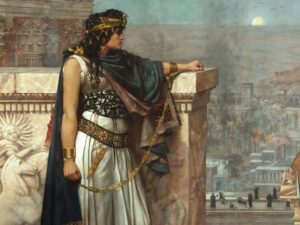Zenobia: The Flower of Arab Womanhood

By: Habeeb Salloum/Arab America Contributing Writer
From atop Fakhir al-Din’s castle, located on a hilltop and overlooking the remains of Palmyra, known to the Arabs as Tadmur, I gazed in wonder at the majestic ruins of this city made famous by Zenobia – labelled in her time ‘Empress of the East’. The pillars and tumbled stones gave me a deep thrill, seemingly conveying a message from long ago. They told of riches, romance and courage produced by a brilliant Arab civilization that flowered for a short period before being snuffed out by the legions of Rome.
These fantastic remnants of a once thriving desert metropolis, 220 km (134 mi) northeast of Damascus, have for centuries inspired romantic recollections by wayfarers and literary men. A leftover from a magnificent civilization in the heart of the Syrian Desert, they still astonish visitors, even in our times. In the past, some believed that only a supernatural being could have conjured such a magnificent metropolis.
“Rise up and go into the world to release it from error and send word to the Jinn and I will give them leave to build Tadmur with hewn stones and columns.”
These were the words God is said to have told Solomon according to the pre-Islamic Arab poet Nabigha al-Dhubyain.
Yet, in spite of all the folklore and fantasy, the actual sheer size of today’s ruins takes one’s breath away. These remnants of a mysterious desert urban centre, bordered by palm and olive orchards, appear as if someone had magically planted a colossal wreck in the barren heart of Syria.
The high bleak hills on two sides provide a dramatic backdrop to the present day ruins, making them unmatched in their spectacular grandeur. They are one of the most majestic and wonderful relics in the world – a fabulous leftover from an extraordinary Arab civilization that reached its zenith some four centuries before the dawn of Islam.
The miracle of Palmyra’s existence in the middle of the desert is due to the hot water spring called Afqa. Its sulphurous mineral waters, besides giving life to the oasis, is said to aid in the treatment of chest and liver ailments, anaemia and skin diseases. It now forms a part of the Palmyra Cham Palace Hotel where guests can relax in its soothing waters.
The history of the city goes back at least 4000 years, but it was only after the Romans made Palmyra a protectorate in the 1st century A.D. that it rose to importance and became a centre of affluence. It became a frontier post, guarding against the Persian peril beyond the Euphrates River.
Its location astride the trade route between Duro-Europos on the banks of the Euphrates and ancient Emesa, today’s Homs, gave it the power to exact taxes on all caravans using the oasis as a stopover. The city flourished economically and its commercial attributes became well known throughout the ancient world.
It grew into an influential buffer kingdom between Roman Syria and Sassanian Persia. For a number of years Palmyra became the centre of a spectacular Arab/Roman autonomous state, which extended from the Caucus Mountains to the Nile Valley. This large empire was built then lost, under the remarkable Queen Zenobia – a proud descendant of a Aramaeo-Arab dynasty ruling Palmyra under the auspices of Rome.
After the Roman Emperor Valerian, in 260 A.D., was defeated and captured by the Sassanians, the uncrowned king of Palmyra, Udhaynat II (“Little Ears” in Arabic) (Roman form: Odenathus), soon thereafter avenged the defeat. After he crushed a series of Persian armies, in gratitude, the Emperor Gallienus made him ‘Corrector of all the East’. The Roman senate declared him Augustus and, in a haughty display of autonomy from Rome, Udhaynat took on the title ‘King of Kings’.
At the height of his victorious career in 267 A.D. his nephew murdered him. A man of great ability in his own right, he has come down in history as the husband of Zenobia. Some historians even attribute Udhaynat’s renowned victories to the genius of his wife. After his death, his young son Wahb-Allat (the gift of the god Allat) (Roman: Vaballathus), was installed on the throne, but real control remained in the hands of his mother Zenobia.
Also known by her Semitic name, Bath-Zebinah (daughter of the merchant), and called by the Bedouins, who trace her pedigree to the tribe of Bani Samayda, Sitt Zaynab, she was, even before assuming power, renowned for her pride, womanly graces, learning and achievements. A highly beautiful and intelligent woman, she is said to have had a divinely expressive countenance, a well-shaped and graceful body, and a clear and strong voice.
A Roman historian, Cornelius Capitolinus, declared that Zenobia was the `handsomest of all Oriental women’. One of the most fascinating and interesting conquerors to stride across the deserts of the Middle East she was to become, in myth and legend, ‘Queen and Empress of the East’.
Describing her and her court in its days of glory, Philip Hitti in his History of Syria, writes:
“Brunette in complexion, with pearly teeth and large flashing eyes, she conducted herself in regal dignity and pomp in a resplendent court modelled after that of the Chosroes… On state occasions she wore a purple robe fringed with gems and clasped with a buckle at the waist leaving one of her arms bare to the shoulder. She rode, helmet on head, in a carriage shining with precious stones.”
Of half-Greek/half-Arab ancestry, Zenobia became an eminent woman of the classical world. Influenced by her education in Alexandria, she claimed to be descendent of Cleopatra. An accomplished and talented woman, she was fluent in Aramaic, Arabic, Greek, Latin and had a perfect command of the Egyptian language.
Soon after Udhaynat’s death, resenting Roman encroachment on her territory and taking advantage of Rome’s troubles with the Germanic tribes, she declared herself Augusta and laid claim to the eastern half of the Roman Empire. In 269 A.D., she defeated the army of the Roman general Heraclianus, sent by the Emperor Gallienus against her, and took control of Syria and most of Mesopotamia and Arabia. The following year her armies occupied Egypt, then challenged Rome in Asia Minor, advancing as far as Ankara in present day Turkey.
Zenobia’s military conquests were the most spectacular the Middle East had seen since the days of Alexander the Great. In a few short years, she became Rome’s most serious threat since Hannibal. An ambitious, dignified and proud woman, she minted coins in her image and led her armies personally in battle. She would ride on horseback or walk at the head of her infantry for immense distances.
Under Zenobia’s rule of only five years, Palmyra expanded until it became an imperial city of some 200,000, noted for its golden pillars and stately mansions. It became one of the most important centres of power in that age – an exciting and adventurous place to live. The city attracted some of the best minds in the Hellenistic world like Cassius Longinus, who was to become Zenobia’s principle advisor.
Rome bided her time and built up its army in the east. In 272 A.D., the Roman Emperor Aurelian besieged Palmyra, but Zenobia slipped through the siege and fled by camel across the desert to seek Persian help. However, as she tried to cross the Euphrates she was captured by the Roman forces and in August of the same year her city capitulated.
Aurelian put many of Palmyra’s leading citizens, including Cassius Longinus, to death. However, admiring the Queen’s courage and beauty, the Emperor spared her life. He brought her back to Rome and paraded her in gold chains through the city streets. In the ensuing years, she was given a pension and a villa in Tivoli, not far from Rome. It is said that she was too haughty to live in captivity and soon thereafter died.
A few years after Zenobia’s capture, the Palmyrans rebelled and were again defeated. Aurelian razed the city but took back to Rome the Palmyran sun-god Shamash and built for him a lavish temple. He established on December 25th, the winter solstice, an annual festival to the sun.
When the Roman Empire became Christian, this date became Christ’s birthday. The changeover was principally done to make the new religion more acceptable to the masses that had enjoyed the celebrations devoted to Shamash. Strange as it may seem, it was due to Zenobia’s defeat that Christmas is celebrated in December.
After Zenobia’s demise, Palmyra’s star began to wane. Subsequently, the city reverted back to its ancient Semitic name of Tadmur and faded into oblivion until rediscovered, in the 18th century, by the Europeans. Today there are very few ruins that are more magnificent or romantic – to travellers a constant object of awe.
Visitors walking between the stones will feel they have stepped back into the history of a superb civilization. The ancient walls, arches, bas-reliefs, columns, statues, temples and tombs make Palmyra Syria’s top tourist attraction.
To me, the dominating 17th century Emir Fakhir el-Din castle appeared to be a guardian watching over Zenobia’s city – majestic and haughty in its eternal isolation. As I watched the sun setting, throwing the castle’s shadows toward the ruins, I experienced a haunting dream of how Palmyra must have appeared in its days of glory when it was truly the Queen of the Syrian Desert’.
In this magical atmosphere, it was easy to reminisce about the fabled Zenobia who through the centuries writers have called: ‘the pious and holy queen’, ‘the fairest flower in the East’ and ‘the most lovely and heroic specimen of her sex’. For me, as for many others, she is without doubt ‘the flower of Arab womanhood’.
Habeeb Salloum M.S.M.
References
Ball, W., Syria: A Historical and Architectural Guide, Scorpion Publishing Ltd., Essex, 1994.
Browning, I., Palmyra, Ghatto & Windus Ltd., London, 1979.
Jenner, M., Syria-in-View, Longman, Essex, 1986.
Haag, M., Syria & Lebanon, Cadogan Books, London, 1995.
Hitti, P.K., History of Syria, Macmillan & Co. Ltd., New York, 1957.
Trimingham, J.S., Christianity Among the Arabs in Pre-Islamic Times, Longman, London, 1979.
Wright, Dr. W., An Account of Palmyra and Zenobia, Thomas Nelson and Sons, London, 1895.


